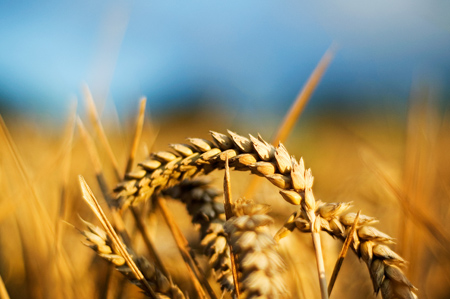Column: Kansas Wheat Yields Set to Banish Bad Memories of Last Year’s Harvest
Category: Grains

(Reuters) – Crop scouts in Kansas are likely to observe one of the best winter wheat crops the state has ever produced, even though the plants are behind in maturity. Kansas produces about a quarter of all U.S. winter wheat, and current conditions are among the best in recent memory.
The annual Wheat Quality Council tour is under way in Kansas, and tour scouts are gauging yield potential for the hard red winter wheat crop prior to the first forecast of the season from the U.S. Department of Agriculture, due at the end of next week.
As of Sunday, USDA had rated 58 percent of winter wheat in Kansas as good or excellent, the highest percentage for that week since 2012. That is sharply up from last year’s drought-stricken crop that was rated only 13 percent good-to-excellent at the end of April.
Crop scouts should have high hopes for Kansas yields this year, but the recent track record suggests the final yield given at the end of the tour could end up too conservative.
Since 2000, the tour yield has been too low relative to the final Kansas yield only eight times. But four of those times were in the last four years, which contained both record yields and lousy yields.
Good crop conditions do not make it more or less likely for the tour yield to deviate from USDA’s May yield or the final yield. There is no correlation between crop conditions and the tour yield bias.
As of midday Tuesday, the first day of the tour, some of the scouts were finding yields in the mid-40 bushel-per-acre range, some as high as 50. The five-year average for wheat sampled across northern Kansas on the first day of the crop tour is 39.5 bushels per acre.
IMMATURITY NOT A PROBLEM
Despite the good conditions, emergence from the winter was slow due to a cold start to spring. As of Sunday, only 4 percent of the Kansas wheat crop was headed versus a five-year average of 22 percent.
The head is the part of the wheat plant that houses the kernels, where the grain is produced. This is usually a key feature to inspect while on tour, but scouts’ findings should not suffer in its absence.
Of the past 19 years, there have been seven in which the tour’s final yield was within 5 percent or less of what USDA eventually forecasted in May. In those seven years, heading progress was between 2 and 11 percent by the end of April, below the long-term average of about 18 percent.
The same theory holds when comparing the tour yield to the final yield. There is no distinct effect of varying crop maturity on the tour bias.
Kansas had a very delayed wheat crop a year ago, too, as only 2 percent of the wheat was headed as of April 29, just a couple of days before the tour began. At the end, the tour pegged the state’s wheat yield at 37 bushels per acre, identical to USDA’s May forecast and just 1 bushel below the final.
However, the immaturity could become a problem if the temperatures suddenly turn too hot in May, which could stress the underdeveloped wheat.
2016 POSSIBILITIES?
Kansas set its high winter wheat yield watermark in 2016 with a massive 57 bushels per acre, about 23 percent above the long-term trend and far higher than the previous record of 49 bpa set in 1998.
The 2019 Kansas crop is unlikely to match 2016’s 467 million-bushel harvest since overly wet fall weather curbed wheat plantings at 7 million acres versus 8.5 million in 2016. But there is some potential for the yields to be close.
On May 1, 2016, some 52 percent of the Kansas winter wheat crop was rated in good or excellent condition, a smaller percentage than today. Four weeks later, that rating had climbed to 60 percent.
The 2019 crop is in a much different stage, though. Some 49 percent of Kansas wheat was heading by May 1, 2016, well ahead of both the average and the current. This makes it difficult to directly compare the years.
However, good end-of-April conditions correlate pretty well with final yields, at least in terms of the deviation from trend. Out of the last 19 years, there were nine in which more than 40 percent of Kansas’ wheat was rated good-to-excellent by the end of April. Only one of those nine years (2012) ended up with below-trend yields, but the deviation was small.
TOUR SPECIFICS
Over three days, wheat tour scouts measure the average number of stalks per foot (30 cm) and the row spacing in fields all over the state. With those numbers, they compute a rough yield based on historical averages of head counts and average weights per head.
The yield projections given by the tour, particularly those that come off individual routes or fields, should be used strictly as a guide and not a final number because the formula does not consider test weight or harvesting losses, which vary from year to year.
More than 90 percent of Kansas’ wheat crop is grown in the western two-thirds of the state, so crop scouts will spend most of their time in these areas. The heaviest wheat-producing district is the South Central, which grows 23 percent of the crop.




